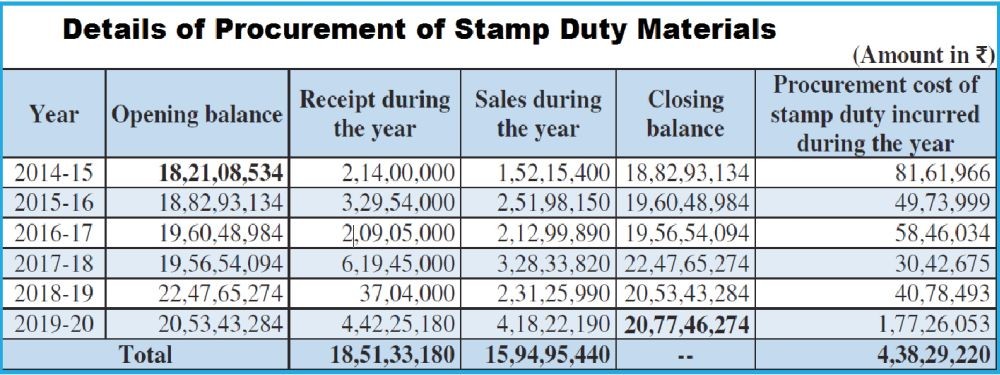CAG’s Report on Economic, General and Revenue Sectors of Government of Nagaland for the Year ended March 31, 2020.

Morung Express News
Dimapur | April 10
Lack of planning and proper monitoring mechanism regarding procurement and supply of stamp duty materials resulted in accumulation of Rs 20.77 crore stamp duty materials, revealed the recent report of the Comptroller and Auditor General (CAG) of India.
No stock verification was conducted to confirm the actual physical availability of these materials, informed the CAG’s report on Economic, General and Revenue Sectors of Government of Nagaland for the Year ended March 31, 2020 (Report No 2 of 2022).
The CAG flagged the issue while analysing the revenue sector pertaining to State’s Finance Department (Treasuries & Accounts).
As per the report, Rule 210 of GFR 2017 states that the officer-in-charge of stores having custody of goods and materials, especially valuable and/ or combustible articles, shall take appropriate steps for arranging their safe custody, proper storage accommodation, including arrangements for maintaining required temperature, dust free environment, etc.
Rule 214 further states that depending on the frequency of requirement and quantity thereof as well as the pattern of supply of a consumable material, optimum buffer stock should be determined by the competent authority, it said.
Highlighting its concern, the CAG noted that the Non-Judicial Stamp papers (NJS) (NJS) are used in matters which concern transactional arrangement between parties, which are not judicial in nature, but used to make agreements, affidavits, lease, amendments in article, etc.
Further, Court fee stamps are required by people who file cases in the court. Documents are notarised to prevent any kind of fraud document and impede someone from presenting a forged document, it said.
The stamp materials (non-judicial stamps, court fee stamps, notary stamps, etc.) are printed at the Government Security Press at Nasik and Hyderabad based on the indents received from the State Government.
The CAG informed that the cost of the printed stamp material is initially borne by the State Government. These printed stamp materials are then received by the State Government and sold to vendor/ public according to the face value to generate stamp duty of the State Government.
Scrutiny of records on March 2020 of the Principal Director, Treasuries and Accounts, Kohima revealed that Government of Nagaland sanctioned an amount of Rs 4.38 crore for printing cost of non-postal stamps during 2014-15 to 2019-20, it said.
As per the CAG, the Department paid the full amount through 14 cheques against printing of stamp duty materials from the Government Press’ at Nasik and Hyderabad.
It was observed from records that stamp duty materials of face value Rs 18.21 crore in different denominations were in stock (from April 2014). However, the Department continued to procure stamp duty materials on a year to year basis.
Accordingly, the national auditor revealed that there was huge stock (Rs 18.21 crore) at the beginning of the year 2014-15 and the total outflow (Rs 15.95 crore) during the last six years (2014-20) was much less than the opening balance of stock (Rs 18.21 crore).
The procurement of additional stamp duty materials of various denominations face valued at Rs 18.51 crore during 2014-20 by the Department without stock verification and assessment of actual requirement resulted in accumulation of huge stock of Rs 20.77 crore (as of March 2020) besides incurring “unnecessary procurement cost.” (See table/image)
Haphazard ‘storage’
As per the report, a Joint verification in January 2020 of the strong room in the office of the Kohima North Treasury revealed that the accumulated revenue papers, court fee stamps, NJS papers, etc of different denominations were dumped haphazardly.
As the stamp duty materials were not stocked properly and systematically, audit could not ascertain the actual position in spite of the efforts being made during the joint verification of the stock, it said.
The CAG further stated that the Senior Treasury Officer and Treasury Staff in charge of strong room could not quantify the denomination-wise actual physical availability of the stamp duty materials.
The lack of proper storage carries with it the risk of the valuable stamp duty material becoming unusable/ getting destroyed/ mutilated, it noted.
The CAG, hence, concluded that planning and proper monitoring mechanism regarding procurement and supply of stamp duty materials resulted in accumulation of Rs 20.77 crore stamp duty materials of various denominations.
Meanwhile, the Department in a reply in July and September 2021 stated that “due to some communication gap, stamps were procured in excess, however, the system of procurement of stamps has now been rectified based on demand.”
Accepting accumulation of huge stock of stamps, the Department further informed that the ‘almirahs’ in the strong room are now been labeled properly and it is trying to streamline the procurement process.
Accordingly, the Department further requested for an opportunity to rectify the lacunae in planning and monitoring mechanism, the report noted.
Recommendations
Based on the audit findings, the CAG recommended that the Department should ensure that the actual quantity of requirement is determined by obtaining demands from the treasuries.
Assess the actual quantity available through regular physical verification of stock before indent for printing of stamp duty materials, it noted.
The State Government should assess and quantify the mutilated stocks and initiate steps to write off the damaged stamps, it suggested.
The CAG also advised the Department for frame inventory management guidelines fixing stock limits such as minimum, maximum and re-ordering levels of various stamp duty materials, ensure proper storage of the usable stock and may adopt system like FIFO (First-In-First-Out).




